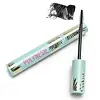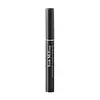Vivienne Sabo Paris Polynèsie Francaise Water-Resistant Mascara Versus Trish McEvoy High Volume Tubular Mascara
What's inside
What's inside
 Key Ingredients
Key Ingredients

 Benefits
Benefits

 Concerns
Concerns

 Ingredients Side-by-side
Ingredients Side-by-side

Water
Skin ConditioningLanolin
EmollientAcrylates Copolymer
Glyceryl Stearate
EmollientStearic Acid
CleansingGlyceryl Behenate
EmollientPropylene Glycol
HumectantAlcohol
AntimicrobialPotassium Hydroxide
BufferingXanthan Gum
EmulsifyingPPG-2-Deceth-30
EmulsifyingSodium Laureth Sulfate
CleansingSodium Dehydroacetate
PreservativePhenoxyethanol
PreservativeMethylparaben
PreservativePropylparaben
PreservativeBHT
AntioxidantCI 77499
Cosmetic ColorantWater
Skin ConditioningAcrylates/Ethylhexyl Acrylate Copolymer
Glyceryl Stearate Se
EmulsifyingCeteth-15
EmulsifyingAlcohol
AntimicrobialStearic Acid
CleansingNylon-6
PEG-12 Carnauba
Emulsion StabilisingCopernicia Cerifera Wax
Pvp
Emulsion StabilisingPhenoxyethanol
PreservativeMethylparaben
PreservativePotassium Hydroxide
BufferingButylparaben
MaskingPropylparaben
PreservativeLaureth-21
CleansingOzonized Jojoba Oil
EmollientSqualane
EmollientSodium Dehydroacetate
PreservativeSilica
AbrasiveIron Oxides
Titanium Dioxide
Cosmetic ColorantWater, Acrylates/Ethylhexyl Acrylate Copolymer, Glyceryl Stearate Se, Ceteth-15, Alcohol, Stearic Acid, Nylon-6, PEG-12 Carnauba, Copernicia Cerifera Wax, Pvp, Phenoxyethanol, Methylparaben, Potassium Hydroxide, Butylparaben, Propylparaben, Laureth-21, Ozonized Jojoba Oil, Squalane, Sodium Dehydroacetate, Silica, Iron Oxides, Titanium Dioxide
Ingredients Explained
These ingredients are found in both products.
Ingredients higher up in an ingredient list are typically present in a larger amount.
Alcohol comes in many different forms. Different types of alcohol will have different effects on skin. This ingredient is usually an astringent alcohol.
These alcohols are drying on the skin. They may strip away your skin's natural oils and even damage your skin barrier. Astringent alcohols may also irritate skin.
Other types of astringent alcohols include:
According to the National Rosacea Society based in the US, you should be mindful of products with these alcohols in the top half of ingredients.
Any type of sanitizing product will have high amounts of alcohol to help kill bacteria and viruses.
Fatty alcohols come from plant oils such as coconut oil. These can help hydrate the skin and are non-irritating. Some fatty alcohols include cetyl and stearyl alcohol.
Learn more about AlcoholMethylparaben is a preservative and is a paraben. It is used to prevent the growth of fungus, mold, and other harmful bacteria. Parabens are chemicals used as preservatives in both cosmetics and food.
Methylparaben can be synthetically created. It can also be found naturally in some fruits, such as blueberries.
Oftentimes, Methylparaben is combined with other parabens to help increase the shelf life.
The safety of Methylparaben is currently being studied. While ongoing studies are looking into the safety of parabens, the results have been very mixed. Some studies have not found Methylparaben to be harmful.
Learn more about MethylparabenPhenoxyethanol is a preservative that has germicide, antimicrobial, and aromatic properties. Studies show that phenoxyethanol can prevent microbial growth. By itself, it has a scent that is similar to that of a rose.
It's often used in formulations along with Caprylyl Glycol to preserve the shelf life of products.
Potassium hydroxide is commonly known as caustic potash. It is used to fix the pH of a product or as a cleaning agent in soap. In cleansers, it is used for the saponification of oils.
Sapnification is the process of creating fatty acid metal salts from triglycerides and a strong base. During this process, Potassium Hydroxide is used up and is not present in the final product.
Using high concentrations of Potassium Hydroxide have shown to irritate the skin.
Learn more about Potassium HydroxidePropylparaben is a preservative and is a paraben with antifungal and antimicrobial properties.
This ingredient can be naturally found in plants and insects, but most of it is synthetically manufactured for human use. In cosmetics, it is usually created by reacting para-aminobenzoic acid and propanol (an alcohol).
You can usually find this ingredient in water-based products.
Parabens have come under controversy due to the claim they are hormone disruptors. Studies show conflicting results. We recommend speaking with a professional if you have any concerns.
Propylparaben is commonly found in food, medicine, and cosmetics.
Learn more about PropylparabenThis ingredient is a preservative with antimicrobial properties. It is the sodium salt of dehydroacetic acid.
It is especially effective at preventing bacterial and fungal growth in low concentrations.
Stearic Acid is a fatty acid. It is an emollient, emulsifier, and texture enhancer.
As an emollient, stearic acid helps soften skin. It aids the skin's protective barrier by preventing water loss. It also provides a gentle cleansing effect without stripping away natural oils.
Stearic acid may also be used to enhance the texture of products. It can add volume and stabilize ingredients such as water and oil. This can help water and oil ingredients from separating.
Sources of stearic acid include animal or vegetable fats/oils such as coconut or shea. It can be naturally found in butter, cocoa butter, shea butter, vegetable fats, and animal tallow.
This ingredient may not be Malassezia folliculitis, or fungal-acne safe.
Learn more about Stearic AcidWater. It's the most common cosmetic ingredient of all. You'll usually see it at the top of ingredient lists, meaning that it makes up the largest part of the product.
So why is it so popular? Water most often acts as a solvent - this means that it helps dissolve other ingredients into the formulation.
You'll also recognize water as that liquid we all need to stay alive. If you see this, drink a glass of water. Stay hydrated!
Learn more about Water